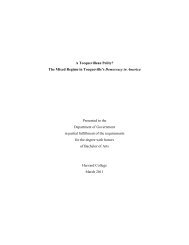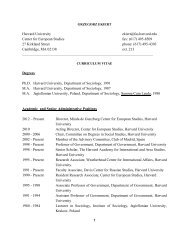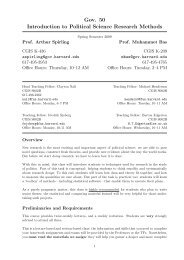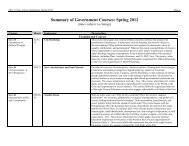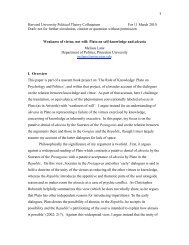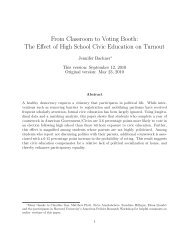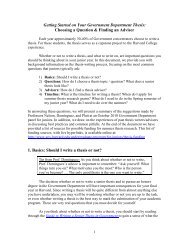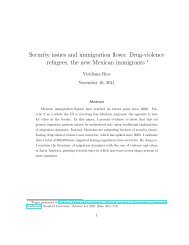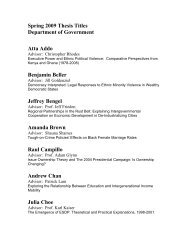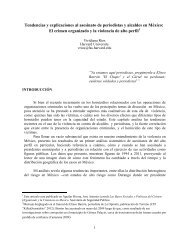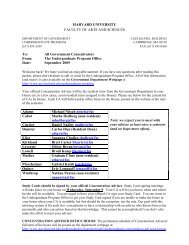Supreme Court Agenda Setting in a System of Shared Powers Ryan ...
Supreme Court Agenda Setting in a System of Shared Powers Ryan ...
Supreme Court Agenda Setting in a System of Shared Powers Ryan ...
You also want an ePaper? Increase the reach of your titles
YUMPU automatically turns print PDFs into web optimized ePapers that Google loves.
6 The Journal <strong>of</strong> Law, Economics, & Organization. V0 N0<br />
colleagues (see, e.g. Maltzman, Spriggs and Wahlbeck, 2000) and, perhaps,<br />
the political branches (Epste<strong>in</strong> and Knight, 1998; Rosenberg, 1991).<br />
Of course, this begs the question, why would the <strong>Court</strong> follow congressional<br />
and presidential preferences? One answer to this question turns on the appo<strong>in</strong>tment<br />
process. Dahl (1957) argues that judicial decision mak<strong>in</strong>g is majoritarian<br />
because presidents and senators, on average, nom<strong>in</strong>ate and confirm a new justice<br />
every two years. S<strong>in</strong>ce politicians can only be expected to appo<strong>in</strong>t justices<br />
whose ideologies track their own, the <strong>Court</strong> should be composed <strong>of</strong> justices<br />
sympathetic to the policy aims <strong>of</strong> the rul<strong>in</strong>g majority (Rehnquist, 1987). As a<br />
result, the <strong>Court</strong> rarely—if ever—will render decisions <strong>in</strong> a manner counter to<br />
the majority’s policy goals. Indeed, this assumption largely undergirds recent<br />
attacks on lifetime tenure (Calabresi and L<strong>in</strong>dgren, 2006a).<br />
A second answer—the one made by strategic SOP theorists—argues that the<br />
<strong>Court</strong> will buckle under congressional and executive preferences because the<br />
political branches have the constitutional authority to punish the <strong>Court</strong> and pass<br />
legislation that alters its policies (Epste<strong>in</strong>, Knight and Mart<strong>in</strong>, 2001). Congress<br />
can <strong>in</strong>itiate and support constitutional amendments to overturn judicial decisions.<br />
It can reduce the <strong>Court</strong>’s budget, alter its composition, strip it <strong>of</strong> jurisdiction,<br />
regulate <strong>Court</strong> procedure, hold judicial salaries constant, and impeach justices<br />
(George and Epste<strong>in</strong>, 1992). Perhaps most importantly, Congress can pass<br />
legislation that overrides <strong>Supreme</strong> <strong>Court</strong> decisions. S<strong>in</strong>ce 1975, each Congress<br />
has overridden an average <strong>of</strong> roughly twelve statutory <strong>in</strong>terpretation decisions<br />
and, dur<strong>in</strong>g the same time period, nearly half <strong>of</strong> the <strong>Court</strong>’s decisions received<br />
some type <strong>of</strong> congressional hear<strong>in</strong>g (Eskridge, 1991; Ignagni and Meernik,<br />
1994). These data suggest that Congress has the ability to respond to <strong>Supreme</strong><br />
<strong>Court</strong> decisions it dislikes and, if it so chooses, to act swiftly.<br />
Presidents also, the story goes, may <strong>in</strong>fluence the <strong>Court</strong>. “Even the members<br />
<strong>of</strong> the <strong>Court</strong> not appo<strong>in</strong>ted by the sitt<strong>in</strong>g president understand that the president’s<br />
status as a nationally elected <strong>of</strong>ficial and his position at the re<strong>in</strong>s <strong>of</strong> every<br />
executive branch agency make him a formidable foe under any circumstance”<br />
(Yal<strong>of</strong>, 2005, 501). Presidents can refuse to enforce the <strong>Court</strong>’s decisions and<br />
order Cab<strong>in</strong>et Secretaries and other high-rank<strong>in</strong>g <strong>of</strong>ficials to ignore them. They<br />
can unilaterally create their own executive policies and shift the policy status<br />
quo (Moe and Howell, 1999; Black et al., 2007), mobilize <strong>in</strong>terest groups to<br />
attack and underm<strong>in</strong>e the <strong>Court</strong>’s decisions (Peterson, 1992), and use their<br />
agenda-sett<strong>in</strong>g power to focus public scrut<strong>in</strong>y on judicial decisions. And, <strong>of</strong><br />
course, they can sign or veto override legislation.<br />
In sum, strategic SOP theorists argue that the comb<strong>in</strong>ation <strong>of</strong> these powers—<br />
even the threat <strong>of</strong> their use—will force the <strong>Court</strong> to anticipate how Congress<br />
and the president will respond to its decisions and make policy <strong>in</strong> compliance<br />
with majoritarian preferences. (Spiller and Gely, 1992; Bergara, Richman and<br />
Spiller, 2003; Harvey and Friedman, 2006; Epste<strong>in</strong> and Knight, 1998). Accord<strong>in</strong>g<br />
to these scholars, if the <strong>Court</strong> (i.e., the <strong>Court</strong> median) perceives that<br />
by vot<strong>in</strong>g for its most preferred alternative it will create policy out <strong>of</strong> step with<br />
key policymakers, it will moderate its decision so as to make policy that is<br />
more favorable to them. Influence from the elected branches, then, forces the



